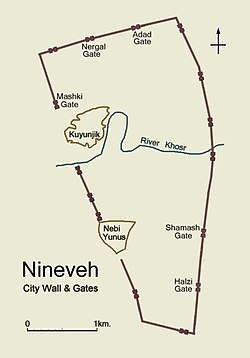Nahum 3
Appearance
| Nahum 3 | |
|---|---|
 Simplified plan of ancient Nineveh, showing city wall and location of gateways. | |
| Book | Book of Nahum |
| Category | Nevi'im |
| Christian Bible part | Old Testament |
| Order in the Christian part | 34 |
Nahum 3 is the third and last chapter of the Book of Nahum in the Hebrew Bible or the Old Testament of the Christian Bible.[1][2] This book contains the prophecies spoken by the prophet Nahum, and is a part of the Book of the Twelve Minor Prophets.[3][4] This chapter describes the cause of the destruction of Nineveh.[5]
Text
- The original text is written in Hebrew.
- Some of the most ancient manuscripts containing this chapter are:
- In Hebrew:
- Masoretic Text
- Dead Sea Scrolls: 4QpNah, known as the "Nahum Commentary" (1st century BC)[6]
- In Greek:
- Septuagint (3rd century BC)
- In Hebrew:
- This chapter is divided into 19 verses.
Structure
This chapter can be grouped:
- Nahum 3:1–7 = IV. The Cause of the Destruction: The woe of Niniveh
- Nahum 3:8–15 = Comparison to other lands
- Nahum 3:16–19 = The final judgment
Verse 8
- Are you better than No Amon
- That was situated by the River,
- That had the waters around her,
- Whose rampart was the sea,
- Whose wall was the sea?[7]
- "No Amon" is translated from Hebrew word: נא אמון nō-’ā-mō-wn,[8] (Jeremiah 46:25; Ezekiel 30:15–16) that is ancient Thebes,[9] referring to the Egyptian name Niwt-Imn, the "City of Amun" that was used for the city from the end of the New Kingdom period. The well-fortified Thebes in Egypt fell to Ashurbanipal in 661 BC, and here is used as a "solemn warning to proud Niniveh" that would fall despite its excellent defenses (vv. 14-19.).[5]
- "River" refers the Nile and the surrounding canals.[10]
Verse 9
- Ethiopia and Egypt were her strength,
- And it was boundless;
- Put and Lubim were your helpers.[11]
- Ethiopia in the Hebrew text is כוש Cush[12]
- "Put" and "Lubim" is identified as Lybians (2 Chronicles 12:3; 2 Chronicles 16:8; Jeremiah 46:9; Ezekiel 30:5; Ezekiel 38:5; Daniel 11:43).[5]
Verse 19
- Your injury has no healing,
- Your wound is severe.
- All who hear news of you
- Will clap their hands over you,
- For upon whom has not your wickedness passed continually?[13]
The message in this final verse of the Book of Nahum gives a positive encouragement and "message of comfort for Israel, Judah, and others who had experienced the "endless cruelty" ("wickedness passed continually") of the Assyrians."[14]
See also
- Ashurbanipal
- Thebes
- Other related Bible parts: Nahum 1, Hebrews 10, Revelation 18
References
- ^ Halley, Henry H. Halley's Bible Handbook: an abbreviated Bible commentary. 23rd edition. Zondervan Publishing House. 1962.
- ^ Holman Illustrated Bible Handbook. Holman Bible Publishers, Nashville, Tennessee. 2012.
- ^ J. D. Davis. 1960. A Dictionary of The Bible. Grand Rapids, Michigan: Baker Book House.
- ^ Therodore Hiebert, et.al. 1996. The New Intrepreter's Bible: Volume: VII. Nashville: Abingdon.
- ^ a b c The Scofield Study Bible, Oxford University Press. 2003. ISBN 9780195278583. pp. 1185-7.
- ^ VanderKam, James C., The Dead Sea Scrolls Today, Grand Rapids: Eerdmans, 1994. pp. 10-11.
- ^ Nahum 3:8
- ^ Template:StrongHebrew
- ^ Targum and Vulgate read populous Alexandria. New King James Version
- ^ New King James Version
- ^ Nahum 3:9
- ^ Template:StrongHebrew
- ^ Nahum 3:19
- ^ Michael D. Coogan, A Brief Introduction to the Old Testament, (Oxford: Oxford University Press, 2009) 297–298.
External links
Wikisource has original text related to this article:
Look up Nahum in Wiktionary, the free dictionary.
- Unique Pictures Of Nahum Tomb By Kobi Arami
- Jewish translations:
- Nachum – Nahum (Judaica Press) translation [with Rashi's commentary] at Chabad.org
- Christian translations:
- Online Bible at GospelHall.org (ESV, KJV, Darby, American Standard Version, Bible in Basic English)
- BibleGateway
- Nahum – King James Version
 Nahum public domain audiobook at LibriVox Various versions
Nahum public domain audiobook at LibriVox Various versions
